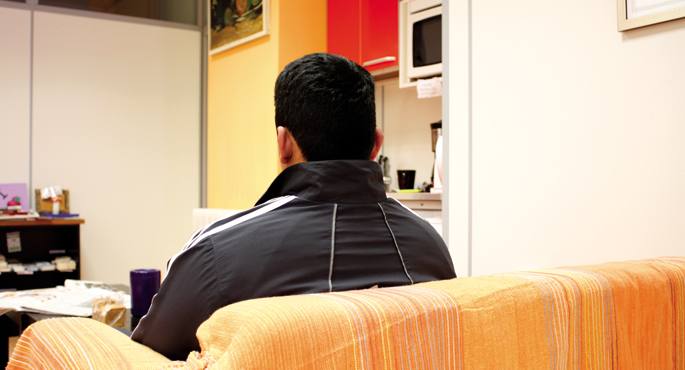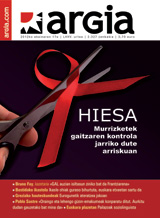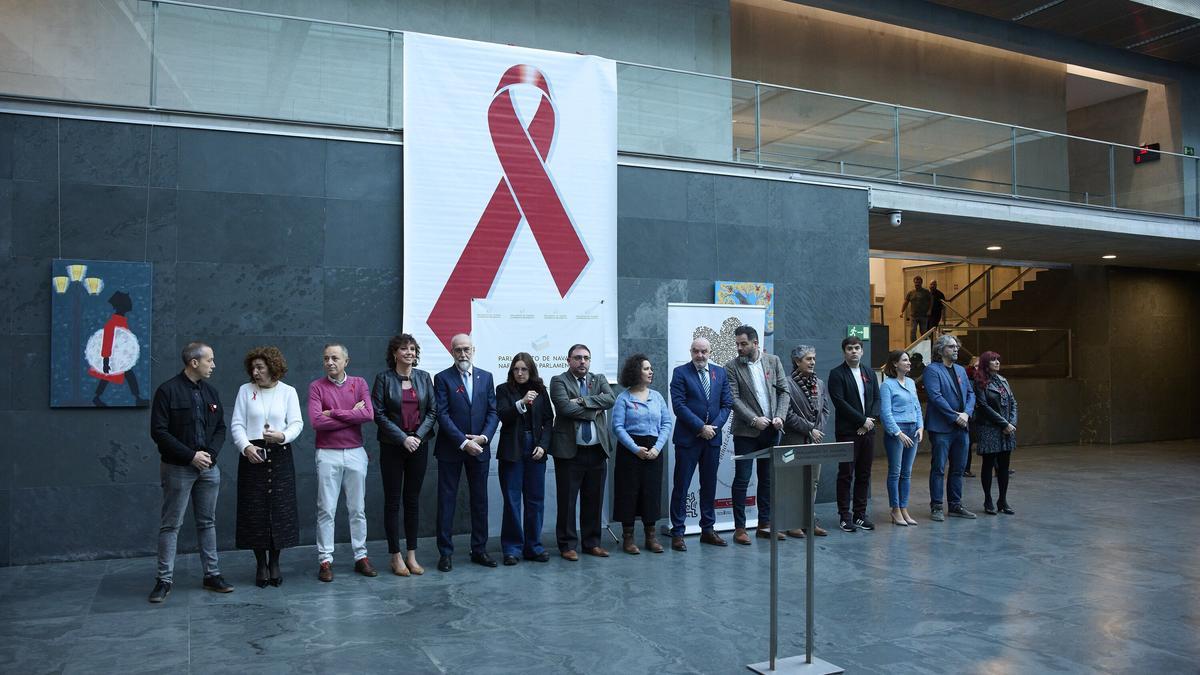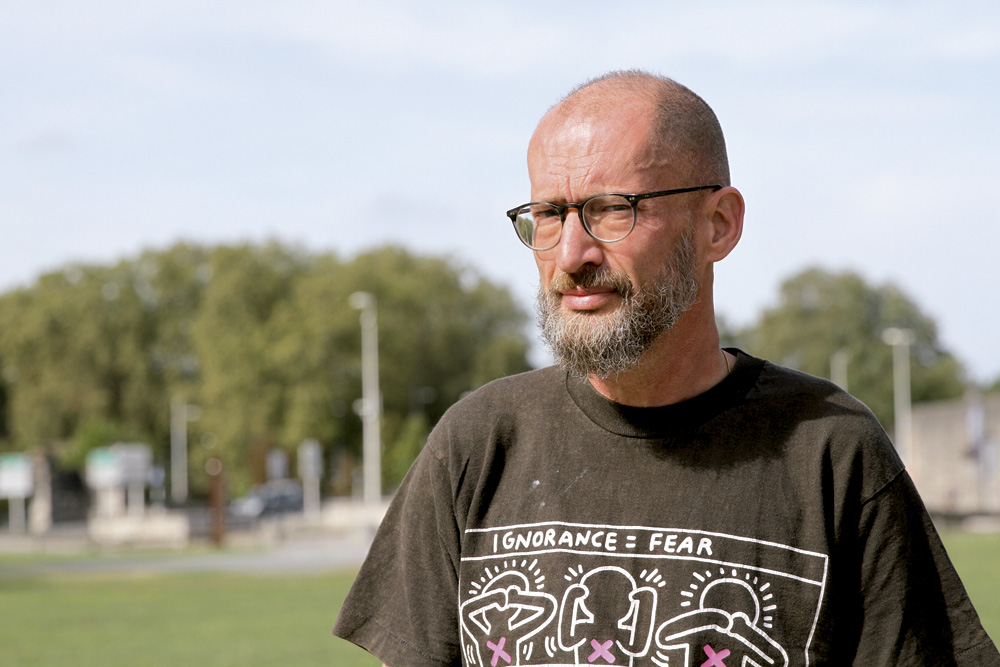Portable... hidden
- The Spanish National AIDS Plan (PIGRN) has just received an economic beating and Osasunbidea has withdrawn anonymous tests to detect the HIV virus in Navarra, but the number of people affected has increased in recent years. It is no longer the terrible and deadly disease of the past, but there are things that have not changed: all those who have testified to us have hidden the face and the name for the report.

It was 2001 and I was admitted to the hospital because I began to lose sight, balance, senses… Doctors thought I had a tumor in my head. At one point, they decided to test for HIV and they knew that I had AIDS, that my defenses were very low, and that's why I was so violently attacked by tocoplasmosis that in itself is not dangerous. Once this was known, it was easy to cope with tosoplasmosis. About ten years ago I had a condom free sexual relationship and I guess I would be infected then, but in ten years I did not notice anything, although by the time I was admitted I already had a very high viral load and very low defenses. It was a shock, but at the same time I reassured myself, knowing that I had no tumor. With me, the family and others, including the members of the couple, knew it, because they were all there, the situation was special.” This is how Gorka was aware of the virus he was carrying inside. The lottery, in the case of the 44-year-old Donostia, has had no choice. Bakarne, Peter and Katamotze received the disease from their former partners in stable relationships, while Xabier became infected in the brothel for exercising without protective measures.
In fact, today the disease is transmitted almost entirely by sexual means, hardly anyone is infected by sharing drug syringes, as in other times. We have transmitted it because the Human Immunodeficiency Virus does not spread; it can spread the flu by air, sneezing… but AIDS is transmitted if you have contact with three substances: blood, sperm or vaginal discharge (the latter with a very low level of contamination). Vertical transmission (from parents to children) is also taking place in the Third World, but measures are being taken in the First World to prevent HIV-positive children from being born, even if parents suffer from a virus.
In
2010 there were 34 million infected in the world, of which 215 were newly diagnosed in Hego Euskal Herria. Profile of the new one with HIV, a man who does not reach the age of 30. “Unwanted pregnancies also increase every year. Neglect? At least, they don't care enough. Young people know the evil, but in today’s society we get so many messages… We have a great lack of education and priority. Schools say it’s the issues that parents have to address, the ones they have to give at school,” says Oiartzun’s Harri Beltza Association President Joseba Errekalde. “Young people have not lived through the hard and deadly years of AIDS, people hear that it is a chronic disease, that is resolved with some pills… but also, over the years I have realized that there will always be people who will not use condoms, because it is very difficult to control the pleasure of the moment. That’s why a good prevention campaign is so important to inform citizens about how important it is to wear a condom at that time”, believes Udiarraga García, member of the Bilbao Waiting Association and president of the Spanish State’s AIDS Coordinator, CESIDA. In addition, he added that the fact that anonymous HIV tests have been being offered for years has also influenced the numbers, as cases of people who no longer knew it have emerged. Some don't do it out of fear, but it's essential to catch the disease in time, before the defenses weaken and end up in the hospital. “The group that has the most surprises is probably at home and in her bed, that of women infected by her husbands. They are often older, older than 60 years, but husbands have had extramarital relationships in slut houses or in whatever cases, and then passed on the virus to their wives.”
Effects of cuts
The Government of Spain has left the National AIDS Plan as an economic problem, but at least García has considered it symbolically important to maintain the Plan, because somehow it is to accept the singularity of AIDS, “because it is a chronic disease, but different, due to its socio-sanitary characteristics, because of the stigma behind it”. Yes, he added that the cuts in money have been a ten year setback in prevention, “because people continue to get infected and we have to repeat preventive strategies every year, because if the issue is not kept quiet, it does not go to the streets”. Concerning the co-payment measures implemented in the health sector, they do not seem to affect the anti-retrovirals that patients receive, as they are not received in pharmacies but in the hospital.
Joseba Errekalde, however, is more concerned about the situation of unregulated immigrants: “Are those people who live in the Spanish State and who are not going to have the Health Insurance Card, who are going to stay out of the system, going to be sent anti-retrovirals? If they stop medicating, they will have a high virus load in the blood and the risk of transmission would be higher, the risk of spreading.” Retroviral treatment controls the immune system so that the
defenses remain stable and the presence of the virus in the blood is zero. Not detecting the virus in the blood means you are asleep, but there is still a risk that you will get infected, although at a very low level. Treatments have greatly improved, especially in side effects, and cases of lipodystrophy – which results in abnormal distribution of fat, such as lipodystrophy and loss of fat in the face – have decreased considerably. Patients receive the medications on a monthly basis and undergo a semi-annual analysis. Peter takes three pills every morning and another two nights, and he just suffers “a little dizziness, perhaps very occasionally.” The steppe is also well located: “Before I got a lot of pills, they also had to be in the fridge, and if I came out, there always had to be a refrigerator nearby, but now I only get two, after breakfast, mechanically. The nightmare, the dream… affected me the first pills, but not since the change of treatment”. On the contrary, Katamotz's body finds it difficult to accept the medicines, despite having tried different treatments. The woman living in Irun (Gipuzkoa) around 1998 received the virus from her former husband and still has to take 12 pills daily because the defense has lowered their guns. Bakarne was also infected by her former 26-year-old husband. Today he is 45 years old and has known the evolution of treatments: “The treatment is chemotherapy level and has severe side effects. I’ve had a lot of diarrhea, belly pains, vomiting, tiredness… In addition, I’ve dedicated myself to new medicines, I looked in the mirror with the medicine I took in 1996 and I didn’t know myself: I had big breasts and vientres and arms and legs like the children of Africa. I've changed the treatment, and slowly I've recovered my appearance. Now I take 6 pills a day, and thinking about the pills in the evening causes me discomfort during the day, because although I'm not hungry, you have to have dinner right and then you have to take the medicines. In addition, it’s uncomfortable, because if you’re away from home you have to hide in the medication.” Hidden
away. This is what the interviewees experience. More than one of them has had to invent several excuses in their work to go to a medical center. Xabier, who became infected last year, is suspected of having lost a job for that reason, because they learned about his illness, which was suspended when the contract was made and everything was underway. The 32-year-old Pamplona has found its support in the Sare association in Pamplona/Iruña. Peter, a 33-year-old Ecuadorian living in Pamplona/Iruña, approached the same society seven years ago when he learned that he had a virus. The ex-girlfriend had told her to do the test, but she was already married to another woman and feared she would have been infected; fortunately, it wasn't. “It’s a secret that we keep my wife and I. I dare not tell anyone, my parents, or my friends. I'd like to tell my parents, but I can't go back anymore, they'd be taken very badly, they'd be sad, because there's very little information about Ecuador. Sometimes I feel the need to talk about it, because I don’t meet other people who have a virus, and I can only feel a bit, but well.” Gorka
has also told the closest ones, although this gives him a contradiction: “I’ve often thought that I’m the first to set the barriers to the normalization of the disease, because I don’t want to make it public, I’m aware, but the image people have of seropositive people is not the one I have, when I’ve ever told them they’ve told me, ‘look, you have no way.’ There is still a lot of ignorance, people are afraid of HIV.” An example of this was the recent report of a 38-year-old woman to Udiarraga García, who explained that she had a virus to people who usually stay walking. Two responded: “Naiara, if you don’t care, when we go out with your nephew don’t come for a walk with us,” “but why?”, “just in case, you get there.” Naiara was cold.
Disregard for society
In daily life, the burden of AIDS is different; some of the interviewees have told us that they lead a normal life, others find it difficult to accept it and live the disease normally. But everyone fears the reaction of society. “Society has not yet recognized it, because from the beginning the disease was limited to specific groups: either you were ‘drug addict’ or ‘slut’ or ‘maricon’, and I am none of the three, but discrimination persists. In addition, people who do not have information still think, unfortunately, that they can get infected with kisses, tears… You have cancer and people say ‘sick, it has touched the cancer’, instead you have AIDS and say ‘it’s the payment of their actions’, but that’s not true,” says Bakarn. Katamotze confesses he feels contempt: “Today’s society doesn’t accept that a person is sick, it just wants super-people who don’t complain. Today, our disease is pretty controlled by medication, and people put a bandage in their eyes, keep it covered, but no one is safe from contagion. We are human and we can get any disease, so it’s important for people to report on AIDS.” According to Gorka, misinformation remains one of the great spaces in which it is immersed.
Gorka is homosexual. Data indicate that there are more cases of infection among gay people, although there has been an increase in the number of people affected by heterosexual intercourse. According to Gorka, there are more campaigns aimed at homosexuals and, therefore, they have more information, “but I would not say that there is more concern than among heterosexuals. I have often been touched by people who do not intend to put the condom, and I have had to put the measures in place. You see the pasotism around you and it seems like something thought about, because you're informed people, you know what you're doing and what can happen."
How to act with new relationships?
Of course, everyone takes action in sexual practices, but at first fear is common. Xabier has been with HIV for a short time and has confessed that she does not behave like before, “you worry more, you are afraid to do some things, but well, little by little it is getting used to and doing it differently.” Most, in sporadic relationships, have not reported the virus, claiming that they have the right not to spread if they behave responsibly; on all occasions when the relationship has stabilized, yes, they have explained to their partner and Xabier and Gorka have received a comprehensive response, but not so for women: “Some couples, when I told them, have made me feel guilty of my illness, dirty, but I have always taken action and have never endangered anyone,” says Bakarn. Katamotz has also often suffered contempt: “They cut directly, life is complicated for many, better to move away, and that also hurts you. The couple I have today is the second stable partner, but I don't have total acceptance on their part and that presses me a little bit, recognizes it, but with conditions. I understand it, but it’s hard…”
Children
Katamotze has shown disappointment at the potential risks, as both her and her former partner had decided not to have children in the couple. Bakarn says directly that she self-mutilated as a woman, removing the possibility of pregnancy from the mind. But Peter has shown that today they can have children without problems. Her wife and she decided that they wanted to have a child, despite the fear caused by the transmission of AIDS. They had two options: the natural way and artificial insemination, but they did not have the means to pay for treatment and sex, with a negative viral load, they told their wife or their child that the risk of transmission was very low. They moved on. Currently, they have a healthy 15-month-old son and neither the mother nor the child have been affected by the flu. However, even if the mother was HIV-positive, 72 hours before delivery she would be given a hard pill cocktail for the child to generate antibodies and even after birth the virus would be completely eliminated.
Xabier has an 8-year-old son. He wants to tell him that he has HIV, but not yet, like a couple of years around here, and he doesn't know very well how he'll explain it, he also thought about writing the letter to him. It is a virus that is only one year old and is adapting to its new life, overcoming, like the rest, the initial concerns. “The first time I made a cut while preparing the food, I was scared, I even thought about playing with the child if I wouldn’t die or not… but then I have seen that playing responsibly there is no danger and that I can play with him normal. That I can kiss him and that nothing happens.”
Teoria sinesgarrienaren arabera, 1950eko hamarkadan tximinotik gizakira egin zuen salto GIB birusak Afrikan eta transmisio kateak hedatu du ordutik. Oraindik birusa akabatzea lortu ez den arren, horretan dihardute hainbat frontetik. Esaterako, GIBa gorputz osora hedatzen duen molekula identifikatu zuten joan den apirilean. Harrigarriagoa da Timothy Brownen kasua: 1995etik infektatua zegoen estatubatuar hau da birusa ezabatzea lortu duen pertsona bakarra. 2006an, leuzemia zuela-eta, hezur-muineko transplantea egin zioten eta horrek sendatu du, GIBarekiko immunea baitzen emailea. Dena den, biztanleriaren %0,3a baino ez da immunea eta beraz irtenbide zaila da. Ikerketa gehiago ere badituzte eskuartean. Adibidez, hiesarekiko erresistente diren globulu zurien erreserbak osatzea, terapia genetikoa erabiliz. Edota molekula-koktel baten bidez, lo dauden birusak aktibatu eta erretrobiralei horiek suntsitzen laguntzea. Bitartean, gaixo kronikoen botiketara bideratzen den dirutzarekin farmazeutikek negozio itzela egiten jarraituko dutela azpimarratu du Bakarnek.
1981ean eman zen hiesaren lehenengo kasuaren berri munduan eta 1984an Euskal Herrian. Azken hamarkadan %17 egin dute gora transmisioek eta lautik batek ez daki birusa duenik. 2010eko datuen arabera, 34 milioi infektatu daude munduan, urte horretan 2,7 milioi infekzio berri izan ziren eta hiesak hildako 1,8 milioi lagun –nahiz eta elkarteek dioten datuetan ez direla aintzat hartzen hiesak ahul utzita beste gaixotasunez hiltzen diren asko–. Hego Euskal Herrian, 215 kasu berri zenbatu ziren 2010ean, gizonezkoak batik bat, eta 52 pertsona hil ziren gaitzaren erruz. EAEn, diagnostikoen %43,7a berandu egin zen eta 38 milioi euro gastatu zituzten tratamendu anti-erretrobiraletan.
Hego Euskal Herrian 2020an 134 kasu positibo atzeman dituzte. Abenduaren lehena da Hiesaren Aurkako Nazioarteko Eguna, eta NBEk ohartarazi du oraindik pandemia hori ez dela amaitu; iaz munduan 680.000 pertsona hil ziren hiesarekin lotutako gaixotasunen ondorioz.
Passionate, guerrilla, passionate 120 battements par minute, like the activism of Act Up. The 1990s are the beginning and AIDS kills a lot of people in France (also), but Parisian activists are not willing to give up, they struggle to put pressure on institutions and... [+]
GIBari heltzeko garaian, guk uste dugu arlo biomedikoan soilik oinarritzen den estrategia ez dela nahikoa LGTB+ komunitateak sexu-osasunean dituen premiei erantzuteko. Lesbiana, Gay, Transexual eta Bisexualen Estatu Federazioak diskurtso inklusibo bat jarri nahi du agerian... [+]
Sutsua, gerrillaria, pasionala da 120 battements par minute, Act Up taldearen aktibismoa bezalatsu.
























